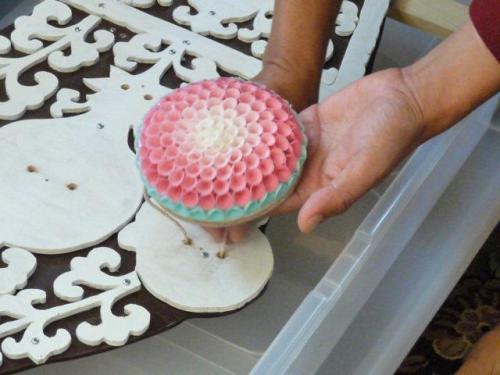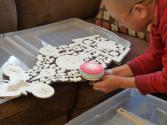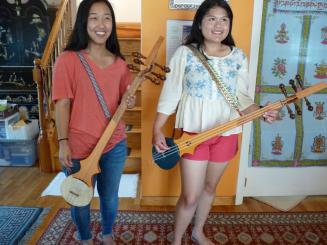Southern New England Traditional Arts Apprenticeship Program, Year 16 - Yeshi Dorjee, Jampa Tsondue, & Kunga Choekyi
SubjectPortrait of
Yeshi Dorjee
(Tibetan, born 1959)
SubjectPortrait of
Jampa Tsondue
(Tibetan, born 1959)
SubjectPortrait of
Kunga Choekyi
(Tibetan)
Date2014 May 4
Mediumborn digital images
ClassificationsGraphics
Credit LineConnecticut Cultural Heritage Arts Program collections
CopyrightIn Copyright
Object number2015.196.252.1-.14
DescriptionTibetan Butter Sculpture Teaching Session during the Southern New England Traditional Arts Apprenticeship Program, Year 16. Yeshi Dorjee, Mentor with apprentices, Jampa Tsondue and Kunga Choekyi.
2015.196.252.1: born digital image showing Yeshi and apprentice KC shaping "mouse ears" that go onto the flower
2015.196.252.2: born digital image of progress of the "mouse ears" that go onto the flower
2015.196.252.3-.4: born digital images showing Yeshi and apprentice KC shaping "mouse ears" that go onto the flower
2015.196.252.5: dipping butter mixture into cold water while shaping it
2015.196.252.6-.7: born digital images showing designs for the base of one part
2015.196.252.8: born digital image showing cardboard pattern for one part of butter sculpture
2015.196.252.9: born digital image showing plywood base for one/third of the sculpture
2015.196.252.10-.11: born digital images showing Yeshi showing the carrier he designed
2015.196.252.12-.13: born digital images showing Yeshi applying one of the flowers to the plywood base
2015.196.252.14: Apprentice KC, her daughter Yangchen, and Yeshi shaping flowers
2015.196.252.14: born digital image showing three people creating butter sculpture
NotesSubject Note: The Southern New England Traditional Arts Apprenticeship Program is a CCHAP initiative since 1997 that fosters the sharing of community-based traditional (folk) artistic skills through the apprenticeship learning model of regular, intensive, one-on-one teaching by a skilled mentor artist to a student/apprentice. The program pairs master artists from Rhode Island, Massachusetts, or Connecticut with apprentices from one of the other states, as a way to knit together members of the same community or group across state lines. Teaching and learning traditional arts help to sustain cultural expressions that are central to a community, while also strengthening festivals, arts activities, and events when master/apprentice artists perform or demonstrate results of their cooperative learning to public audiences. The Connecticut Cultural Heritage Arts Program at the Connecticut Historical Society manages the program in collaboration with the Folk Arts Program at the Massachusetts Cultural Council and independent folklorist Winifred Lambrecht who has a deep knowledge of the folk arts landscape of Rhode Island. Primary funding for the program comes from the National Endowment for the Arts, with support also from the Connecticut Commission on the Arts, the Institute for Community Research, and the Connecticut Historical Society.2015.196.252.1: born digital image showing Yeshi and apprentice KC shaping "mouse ears" that go onto the flower
2015.196.252.2: born digital image of progress of the "mouse ears" that go onto the flower
2015.196.252.3-.4: born digital images showing Yeshi and apprentice KC shaping "mouse ears" that go onto the flower
2015.196.252.5: dipping butter mixture into cold water while shaping it
2015.196.252.6-.7: born digital images showing designs for the base of one part
2015.196.252.8: born digital image showing cardboard pattern for one part of butter sculpture
2015.196.252.9: born digital image showing plywood base for one/third of the sculpture
2015.196.252.10-.11: born digital images showing Yeshi showing the carrier he designed
2015.196.252.12-.13: born digital images showing Yeshi applying one of the flowers to the plywood base
2015.196.252.14: Apprentice KC, her daughter Yangchen, and Yeshi shaping flowers
2015.196.252.14: born digital image showing three people creating butter sculpture
Subject Note: This event was one of the teaching sessions of the apprenticeship team in Tibetan butter sculpture. With support from the Southern New England Traditional Arts Apprenticeship Program in 2013-2014, Yeshi Dorjee taught Jampa Tsondue and Kunga Choekyi the ancient process of hand-crafting butter sculptures over several months, and they assisted him with creating this three-part butter sculpture for the community to use in its ceremonies. Jampa, a painter, and Kunga, an embroiderer, were familiar with the designs of the figures and the flowers that are used in the sculptures, because they use these same designs in their painting and embroidery. Yeshi devised a creative way to store and transport the delicate butter sculptures in plastic bins that have been fitted with plywood supports. As with thangka painting, the production of a detailed artistic work is like a meditation, creating a calm mind and positive collective karma, bringing peace and harmony.
The steps of the apprenticeship in butter sculpture were these:
1. Preparation of base board, the plywood that the butter sculptures are applied on
2. Preparation of the butter (Crisco), melting together, cooling it with ice, then can scoop it
3. Amount of color mixing and shaping into colored cones
4. Flower paddle and leaves, picking up with fingers from the cones, and making shapes
5. Mouse ear flower
6. Precious Jewel Flower
7. Making combination of colors for flowers.
8. Images of animal’s figures
9. Images of deities’s figures
10. How to order them in the sculpture and meaning of all these figures – they tell a story
The butter sculpture was displayed in the exhibit Connecticut Traditional Artists and Their Communities, an exhibit celebrating 25 years of the Connecticut Cultural Heritage Arts Program at the Connecticut Office of the Arts gallery in Hartford from August to November 2016.
Biographical Note: Yeshi Dorjee is a Buddhist monk, who provides spiritual support and teachings for the Tibetan community throughout southern Connecticut and beyond. A multi-talented artist, Yeshi creates sand mandalas, butter sculptures, religious paintings, book illustrations, and is a storyteller.
“Butter sculptures are used in temples, in ceremonies, and in home shrines. This art form dates to the 14th century. People come to meditate by the sculptures – the animals and the images in the sculptures show how to be a good person, how to respect each other, and give spiritual messages important to our daily lives. Traditionally the pictures were made from yak butter which is yellow; now we use butter and crisco with some modern dyes. Sometimes we mix with a little rice, especially in places where it is hot like India. There are two types of butter sculptures, ones that are flowers, and ones that have figures from Buddhist stories and scriptures. I know how to make both types.
We prepare the butter mixture and color it, then we make the little flowers and other shapes. These are pressed onto plywood cut out into the background shape. Sometimes we use plywood shapes as a palette to hold and make individual flower pieces, then these are put into the larger design. For a large sculpture, the monk who knows how to make the flowers does that part, and then the monk who knows the figures and the whole design puts the individual parts onto the big design. All the pieces are made by hand, not molds. Monks who make butter sculptures have certain body characteristics – they have cold hands and dexterous fingers! Sometimes to make the hands colder, monks will use a tourniquet on their arm to control the blood flow.”
Additional audio, video, and/or photographic materials exist in the archive relating to these artists.
Cataloging Note: This project was made possible in part by the Institute of Museum and Library Services MA-245929-OMS-20.
Status
Not on viewJampa Tsondue
2018 March 10
Tentso Sichoe
2017 June 21
Penpa Tsering
2015 July 6



























